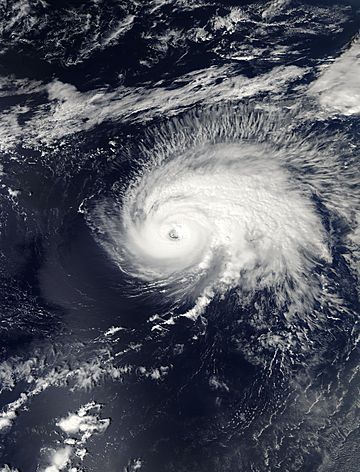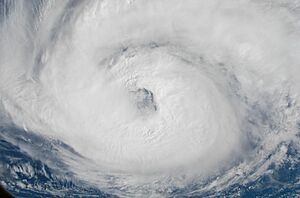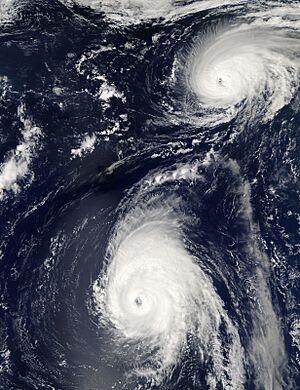Hurricane Gordon (2006) facts for kids
| Category 3 major hurricane (SSHWS/NWS) | |

Hurricane Gordon on September 14.
|
|
| Formed | September 10 2006 |
|---|---|
| Dissipated | September 20 2006 |
| Highest winds | 1-minute sustained: 120 mph (195 km/h) |
| Lowest pressure | 955 mbar (hPa); 28.2 inHg |
| Areas affected | Azores, Iberian Peninsula, British Isles |
| Part of the 2006 Atlantic hurricane season | |
Hurricane Gordon was a powerful storm in 2006. It started as a tropical storm and grew into a strong Category 3 hurricane. This means it had very fast winds. Gordon was special because it was the first hurricane to hit the Azores islands directly since 1991. After it weakened, its leftover parts also brought stormy weather to parts of Western Europe. Gordon was the first "major" hurricane of the 2006 Atlantic hurricane season.
Contents
How Hurricane Gordon Formed and Grew
Hurricane Gordon began as a tropical wave in early September. This wave was first linked to another storm, Hurricane Florence. It was like a smaller ripple behind a bigger wave.
At first, the wave was pulled into Florence's large wind system. But as Florence moved away, this smaller wave broke free. It slowly started to get stronger. On September 10, it became organized enough to be called Tropical Depression Seven. This happened northeast of the Lesser Antilles.
Gordon Becomes a Hurricane
With Florence far away, conditions became better for the storm to grow. On September 11, it became Tropical Storm Gordon. It was moving slowly westward.
Gordon found a clear path near the Azores, which helped it avoid hitting land early on. It kept getting stronger. By September 12, it officially became a hurricane. Less than a day later, it rapidly grew into a strong Category 2 hurricane.
On the evening of September 13, Gordon became a "major hurricane." This was the first major hurricane of 2006. It stayed a major hurricane for over 24 hours. Then, it started to weaken as it moved over cooler water. This weakening began on September 15.

Gordon's Unexpected Strength
The winds guiding Gordon became very weak. This made the hurricane almost stop moving for about 24 hours. Then, a weather system called a trough came and pushed Gordon northeast.
By September 16, Gordon was barely a hurricane. Experts thought it would keep weakening over cooler waters. But something surprising happened! Gordon actually got a little stronger and became more organized. This trend continued for over two days. Gordon slowly gained strength and became a Category 2 hurricane again.
Even though forecasts kept saying it would weaken, Gordon's unexpected strength meant the Azores were now in danger. On the morning of September 19, Gordon reached its second peak strength. Its winds were about 105 mph (165 km/h) before it started to weaken again.
Gordon was still a hurricane when it crossed the Azores. Soon after, it weakened and changed into an extratropical cyclone. This is a different type of storm. The leftover parts of Gordon then mixed with a large low-pressure area in the Atlantic Ocean. This system moved towards the northwest of the Iberian Peninsula. On September 21, it turned north towards southwest Britain and Ireland. By September 22, it was fully absorbed into the larger Atlantic weather system.
Preparing for Hurricane Gordon
People in several areas got ready for Hurricane Gordon.
Azores Islands Get Ready
The Portuguese government put all nine Azores Islands on "red alert." This is the highest warning level. Residents were told to take emergency steps. The Azores Meteorological Service issued hurricane warnings for all the islands.
To keep everyone safe, schools were closed. Fishermen were told to stay on land. People were advised to stay indoors, close all doors and windows, clear storm drains, and move farm animals to safe places. Forecasters warned of winds up to 105 mph (170 km/h). They also expected heavy rain and huge waves up to 12 meters (40 ft) high along the coast.
Spain's Preparations
In Spain, the region of Galicia was also put on red alert. This was because the leftover parts of Gordon were expected to bring strong weather. Classes were canceled on September 21. Eleven other regions in Spain, including Madrid and Andalusia, received lower levels of warning.
British Isles Prepare for Stormy Weather
Stormy weather from Gordon's remnants was expected to affect the 2006 Ryder Cup golf tournament. This event was happening in Straffan, County Kildare, Ireland. There were worries that the tournament might be stopped or delayed. Strong winds and heavy rain from another storm had already caused some damage. This led to concerns about the golf course's condition. Organizers even set aside September 25 as an extra "reserve day" in case of delays.
On September 19, news reports said Gordon's remnants would bring strong winds and rain to parts of the United Kingdom. The UK Met Office warned of "very windy weather" and "exceptionally severe gales" for much of Northern Ireland and Scotland. Northern Ireland was expected to get the worst of it, with gales up to 80 mph. There were also warnings of local flooding, with up to two inches (50 mm) of rain expected. Wales and western England were warned of wind gusts up to 50 mph.
What Happened When Gordon Hit
Luckily, Hurricane Gordon caused less severe damage than expected in many places.
Azores Islands
The Azores islands did not suffer a lot of serious damage. There were reports of trees falling and power lines breaking. This caused power outages in some areas, especially on Santa Maria Island.

Spain
Gordon's remnants hit the northwestern province of Galicia early on September 21. It was a strengthening extratropical storm by then. Wind gusts as strong as 101 mph (165 km/h) were recorded in Fisterra. Even near Madrid, winds reached 65 mph (107 km/h).
Heavy rain fell across Spain, with up to 2.58 inches (65.5 mm) in Canfranc. The air pressure dropped significantly in A Coruña. Waves as high as 7 meters were also reported. Strong winds blew over trees, traffic lights, and signs. One man was hurt when a tree fell on his car. Overall damage was light, but some roads were blocked.
Republic of Ireland
On September 20, practice rounds for the Ryder Cup golf tournament were delayed due to strong winds. However, these winds were from a different storm system, not directly from Gordon.
Gordon's remnants caused stormy conditions late on September 21. About 1,500 homes lost power. The areas most affected were on the east coast between Drogheda and Wexford, and in the south around Cork and Limerick.
Earlier on September 21, a woman at the Ryder Cup in County Kildare was injured. A tree branch fell near the golf buggy she was in. Also, the event's media center had to be evacuated because of high winds. However, the tournament's first day went ahead as planned on September 22.
United Kingdom
The remnants of Gordon reached southwest Britain late on September 21. A wind gust of 81 mph (130 km/h) was recorded. Power lines were hit, leaving over 1,000 homes without electricity in Truro, Cornwall. In Devon, the train line between Exeter and Plymouth was damaged by high waves at Dawlish. This caused delays for train services. A 10-meter (33 ft) section of seawall was also washed away near the tracks. A tree fell onto a campervan in Yeoford, but no one was hurt.
Wind gusts up to 75 mph hit Northern Ireland during the night of September 21 and 22. Up to 100,000 houses lost power as tree branches fell on power lines. Fallen trees caused many problems. In County Down, several people had to be rescued from their cars after trees fell on them. Flooding was also reported in Rostrevor. Many roads across the province were blocked by fallen trees, including the M1 motorway. The Foyle Bridge in Derry was closed for two hours due to strong winds.
In Scotland, high winds led to the cancellation of ferry services from Stranraer and Cairnryan. Trucks on the A715 road had to park on the side of the road overnight because driving conditions were too dangerous.
There was one good effect from Gordon's remnants. In Newquay, Cornwall, large waves up to 2.5 m (8 ft) high made for excellent surfing conditions!
Images for kids
-
Wind damage from the remnants of Hurricane Gordon in Ferrol, Spain
Related pages
- 2006 Atlantic hurricane season
- NHC's archive on Hurricane Gordon
|
Tropical cyclones of the 2006 Atlantic hurricane season |
||||||||||||||||||||||||||
|
|
|||||||||||||||||||||||||
|
|
||||||||||||||||||||||||||
See also
 In Spanish: Huracán Gordon (2006) para niños
In Spanish: Huracán Gordon (2006) para niños



